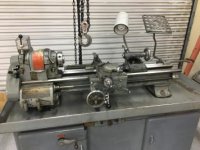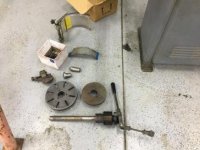Hey folks,
Been lurking a long time, I genuinely appreciate the wealth and breadth of information available here. I've been "casually browsing" machines for 6-8 years now, and just stumbled across a deal that seems too good to be true (I know, I know...).
I'm heading out the day after tomorrow to inspect a 10L and have a couple minor points I haven't yet uncovered in my research/reading.
The best approximation of date I can find based on S/N is 1918 manufacture, and doesn't appear to have hardened ways, which I don't believe were even offered that early.
The carriage lock appears to be missing from photos, and a bit of searching shows that's not an uncommon part to break or vanish on these machines. I have the ILION book, which suggests using this lock as a rough gauge of wear. Is there any analog to this test that can be done in lieu of the carriage lock?
I haven't seen Tubalcain's video series specific to South Bends yet, but plan to watch it before heading out.
Since I've never been deep enough into this process to have to separate hardened or non-hardened ways, is there anything in particular I should be looking out for? I plan to take along an indicator and straight edge to do the topical inspection stuff. The machine is currently under power, but it appears to already be on skids for movement, so I doubt it's leveled and worth taking any cuts, even assuming the seller would allow me to. Obvious things like checking gears for missing teeth, running it in as many speeds as possible to listen for expensive-sounding noises, etc. will happen.
It's a 48" bed, D1-4 spindle, standard range two tumbler gearbox, large dials, taper attachment, comes with a collet draw bar (is it safe to assume 5C on this? The listing says it's not original, and no photo), a couple 6" 3-jaws, an 8" 4-jaw, a face plate, extra backing plate, and some other misc accessories. Doesn't appear to come with a tool post or any tooling, or steady/follow rests, etc. Currently set up on 3ph 220, with a 3ph coolant pump for the flood setup as well. I guess a few parts (tailstock and apron, I believe) have been restored already.
I plan to tear into it and continue/complete the restoration, assuming the machine is worth the effort.
Thanks!
Edit: Re-reading this, I didn't really clearly ask my question; is there anything specific to the non-hardened beds I should look at/inspect and consider a deal breaker? What are the limitations to re-scraping?
Been lurking a long time, I genuinely appreciate the wealth and breadth of information available here. I've been "casually browsing" machines for 6-8 years now, and just stumbled across a deal that seems too good to be true (I know, I know...).
I'm heading out the day after tomorrow to inspect a 10L and have a couple minor points I haven't yet uncovered in my research/reading.
The best approximation of date I can find based on S/N is 1918 manufacture, and doesn't appear to have hardened ways, which I don't believe were even offered that early.
The carriage lock appears to be missing from photos, and a bit of searching shows that's not an uncommon part to break or vanish on these machines. I have the ILION book, which suggests using this lock as a rough gauge of wear. Is there any analog to this test that can be done in lieu of the carriage lock?
I haven't seen Tubalcain's video series specific to South Bends yet, but plan to watch it before heading out.
Since I've never been deep enough into this process to have to separate hardened or non-hardened ways, is there anything in particular I should be looking out for? I plan to take along an indicator and straight edge to do the topical inspection stuff. The machine is currently under power, but it appears to already be on skids for movement, so I doubt it's leveled and worth taking any cuts, even assuming the seller would allow me to. Obvious things like checking gears for missing teeth, running it in as many speeds as possible to listen for expensive-sounding noises, etc. will happen.
It's a 48" bed, D1-4 spindle, standard range two tumbler gearbox, large dials, taper attachment, comes with a collet draw bar (is it safe to assume 5C on this? The listing says it's not original, and no photo), a couple 6" 3-jaws, an 8" 4-jaw, a face plate, extra backing plate, and some other misc accessories. Doesn't appear to come with a tool post or any tooling, or steady/follow rests, etc. Currently set up on 3ph 220, with a 3ph coolant pump for the flood setup as well. I guess a few parts (tailstock and apron, I believe) have been restored already.
I plan to tear into it and continue/complete the restoration, assuming the machine is worth the effort.
Thanks!
Edit: Re-reading this, I didn't really clearly ask my question; is there anything specific to the non-hardened beds I should look at/inspect and consider a deal breaker? What are the limitations to re-scraping?










